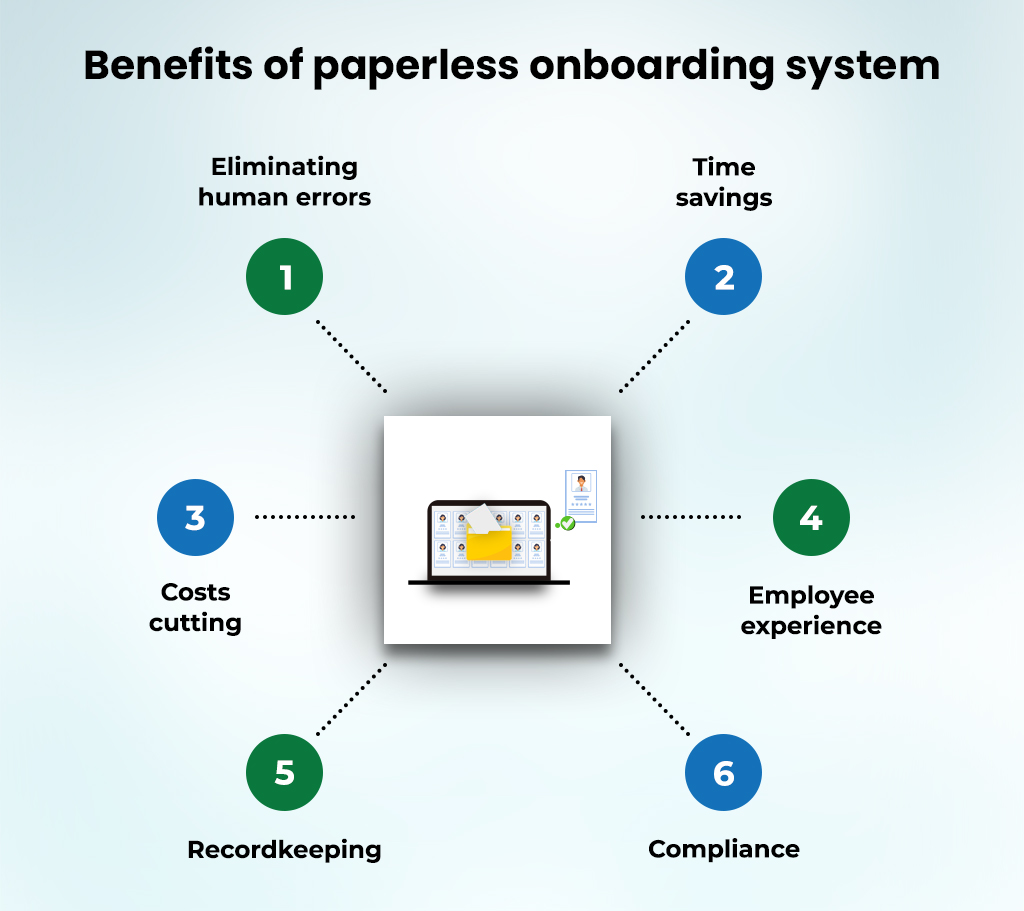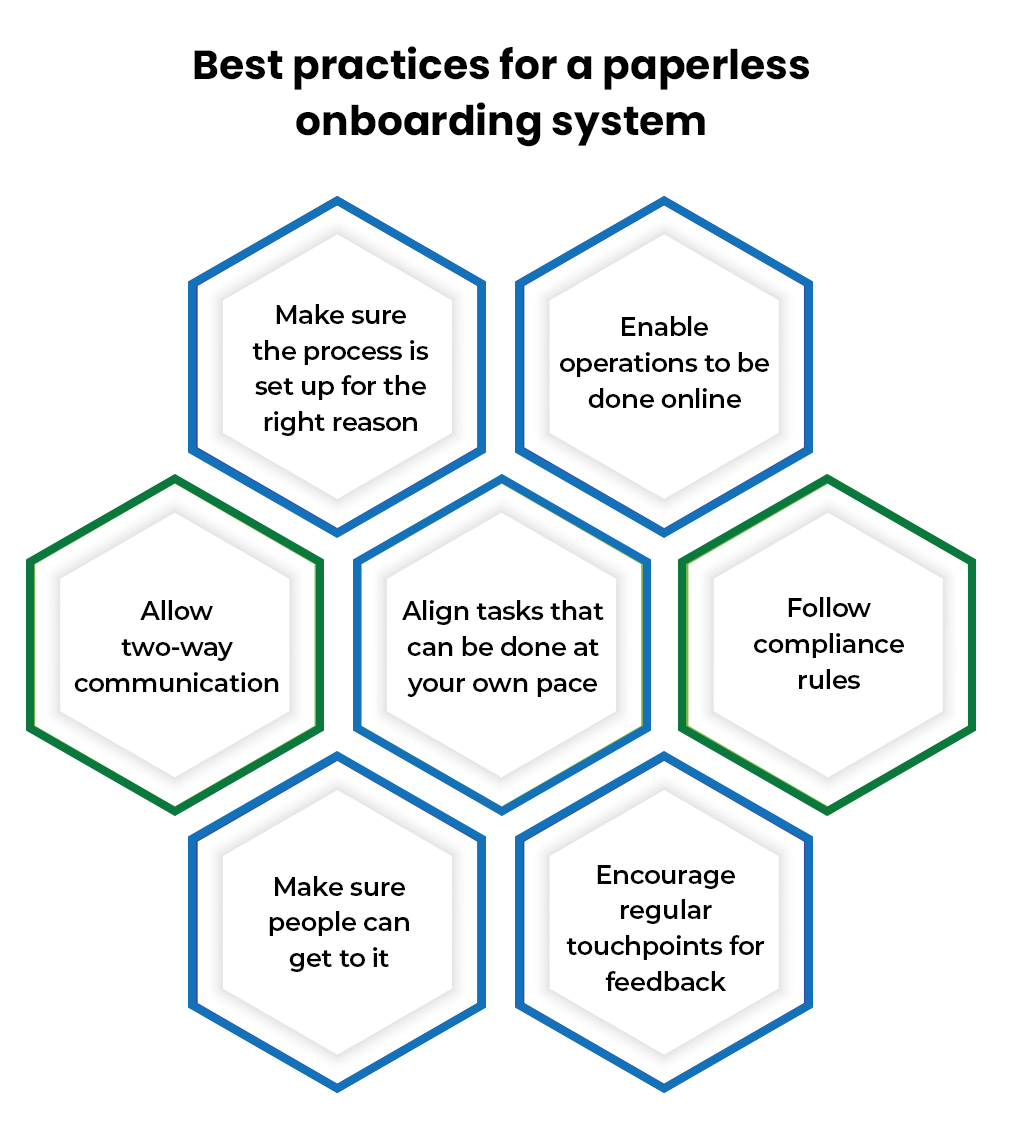Paperless Onboarding System: The Future of Seamless Employee Onboarding
Do you still mail, scan, and file paper documents when you hire new employees? There is a faster and safer alternative: Onboarding without paper. A sound paperless onboarding system will keep all records online in one place, making it easier to find the correct file and keeping sensitive paperwork safe.
I think most businesses can go paperless without too much trouble, and I think the last two years have shown that. During the COVID-19 pandemic, many companies are moving to remote work. This is the perfect time to make sure that your processes for hiring new people are smooth and easy.
If you want to go paperless but don’t know where to start, this short guide will tell you all you have to learn to set up your system.
First, though let’s talk about what paperless onboarding means
The paperless onboarding process speeds up and simplifies using employee onboarding software or a unified HR management solution. With these tools, onboarding is done in a new way that makes it flexible, automatic, and personal. As a result, it makes employees more engaged, reduces ramp-up time, and ensures processes are followed.
Now that we know what paperless onboarding means, let’s look at how it can help.
Benefits of a paperless onboarding system

Moving the onboarding process of your business from pen and paper to the cloud has many benefits. Some advantages are:
- Eliminating human errors
- Time savings
- Costs cutting
- Employee experience
- Recordkeeping
- Compliance
Eliminating human errors
With manual onboarding, it’s only a matter of time before a mistake is made. Errors in data entry can lead to wrong SSN numbers, direct deposits, or W2s. Businesses have to pay IRS fines because of these mistakes. By filling out forms online, information can be shared between different systems without the chance of human error. If mistakes happen, information can be changed quickly in one place and sent to all platforms simultaneously.
Time savings
One of the best things about a paperless onboarding system is how much time it will save your staff. Paperless onboarding eliminates the need to do things by hand, like a print, store, and look for files. The people who work in HR won’t have to look for lost paperwork. This process can be automated by giving new hire paperwork to employees, sending out reminders when forms aren’t filled out completely, and storing documents in a single cloud platform.
There is no need to enter data because the needed information about your employees will be sent directly to other parts of your business. For example, employees can quickly fill out the forms they need to set up payroll and benefits. So, your employees will have a better time working on the business and helping the company reach its goals.
Cost-cutting
Many business owners will like how a paperless onboarding system helps them save money on extra costs. There is no longer a necessity for paper, printing supplies, or storage space. This can save businesses thousands of dollars annually, especially those with many employees. The money saved on costs can then be used to buy better resources for a business. Cloud-based software is a better business run because it saves money and can be expanded.
Employee experience
A process that doesn’t use paper is much better for employees than one that does. New employees can quickly enter their personal information, fill out forms, and even sign up for benefits. This process can also be done at any time from their mobile device. They wouldn’t have to wait to get their first paycheck or benefits.
Record Keeping
In addition to saving time, the paperless onboarding process helps your business keep better records. The paperwork for new hires is kept in one place, making it easy to find when needed. Documents won’t have to be checked on all the time by management. Instead, they can quickly check the status from anywhere at any time on their desktop or mobile device. Also, you don’t need to fear missing a required form because the process can be set up ahead of time to ensure it is the same for each new hire.
The process of getting new employees started is essential if you want to keep them. This is the first time a new employee works for your company, and a well-planned start can retain them longer. As part of a digital experience that gets employees more involved, you can also set up a welcome video and virtual training classes.
Compliance
Compliance goes up for any business when the onboarding process is automated. The needed forms can be set up once at the start and used for every new hire. This means that your approach needs to be consistent and correct. No forgetting to get a Form I-9 or send information about benefits to a new hire.
Also, if you let your employees enter and upload their own information, you reduce the chance of human error right away. Getting rid of mistakes means improving compliance.
Best practices for a paperless onboarding system

Make sure the process is set up for the right reason: To create a paperless onboarding process, management must ask themselves a few key questions, like:
“What impression do you want new hires to have at the end of the first day?” “What should new employees know about the culture and work environment?” and “What goals do you want to set for new employees?” This will help HR figure out the onboarding program’s primary goal and why it exists in the first place.
Enable operations to be done online: From an HR Operations point of view, many onboarding tasks will need to be rethought from a logistical point of view. HR must start by making a list of things to do, such as turning any paper training manuals, employee handbooks, contracts, and policy and procedure packets into digital files. Companies would do better to put money into an employee portal with an onboarding module.
Allow two-way communication: An onboarding system shouldn’t be a one-way way to give information. Instead, it should allow two-way communication and discussion. For example, virtually putting new team members in touch with leaders is a great way to make them feel like they belong. Having one-on-one meetings with new hires is an excellent way to give them support when they need it. A virtual buddy program can help people connect in a fun, casual way.
Align tasks that can be done at your own pace: Self-service modules work best for today’s employees, whether they need to find out about company policies or benefits or upload legal forms. The onboarding HRIS module must be built with the right ways to finish, like email triggers and completion dashboards, to ensure that the process is completed as expected. A self-paced module creates a pull instead of a hard push, putting the new joiner at the center of the process.
Follow compliance rules: There are many governments and legal requirements for new hires, such as employment forms, payroll data, etc. From a compliance point of view, this part of the onboarding system must be made with all the necessary checks and balances. Process workflows must follow quantitative and qualitative rules and be checked at every step by both machines and people.
Make sure people can get to it: Just because something is not visible doesn’t mean people won’t remember it. In fact, new technologies are not even close to being out of sight. Tools for virtual collaboration, like digital conferencing, file sharing, messaging apps, etc., give people a lot of power to work together online. But when HR is making the modules, they need to remember that access is more than just making connections. It also means giving people access to resources, tools, and information that can help them learn to do their jobs well.
Encourage regular touchpoints for feedback: Virtual connect should also work in the other direction, allowing the new hire to give feedback. HR technologies like surveys for new hires, one-on-one meetings, and software for tracking goals and performance can help create these different ways for people to give feedback.
What Beyond Intranet can do for you
No more missing information to find or hard-to-read handwriting to figure out. With Beyond Intranet’s HR Onboarding Software, your organization can reach a new level of paperless efficiency. By letting new employees fill out their onboarding paperwork in a secure web environment, those days of a lot of paper will be over. When it’s time to hire someone, not only is it easier to onboard them, but you can even choose from a variety of email templates to send and welcome your new employees, directing them to your company’s paperless onboarding Portal. Once your new employee has turned in their paperwork, our Onboarding solution keeps working for you.
Time to go paperless with Paperless Onboarding System
In managing the workforce, onboarding is a crucial step. But it is often forgotten or poorly handled when it is managed by hand. So, it can make a wrong first impression on your new hires. Worst of all, a lot of paperwork, missing information, and busy managers can make it take longer for an employee to be productive.
Because of these things, different industries have turned to a single solution for clean, fast, and efficient new paperless onboarding. No matter the kind or size of business, all roads lead to paperless onboarding. Ready to get rid of paper? You can get help from Beyond Intranet. Click here to open the door to a limitless world of easy Paperless Employee onboarding.






